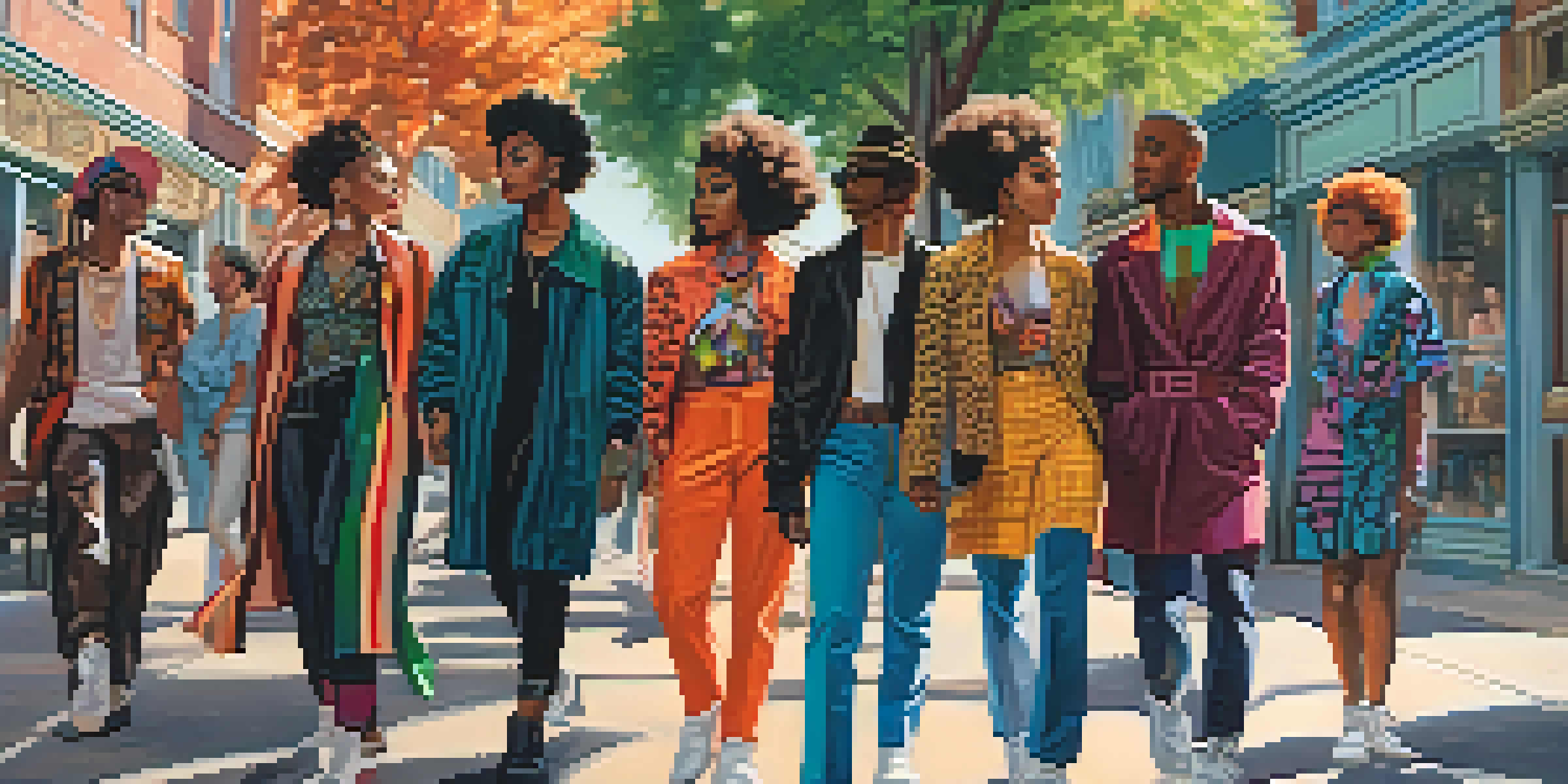Historical Perspectives on Gender Fluidity in Fashion

Fashion as a Reflection of Gender Norms Through Time
Fashion has always been a mirror reflecting societal attitudes towards gender. From the elaborate gowns of the 18th century to the more androgynous styles of the modern era, clothing has often signified not just personal identity but also cultural expectations. These norms, however, have shifted dramatically over time, allowing for greater expression and fluidity.
Fashion is the armor to survive the reality of everyday life.
For instance, the Victorian era enforced strict gender roles that dictated how men and women should dress. Men donned tailored suits while women wore voluminous skirts, reinforcing traditional ideas about masculinity and femininity. Yet, even during this period, there were glimpses of rebellion, with some women adopting masculine styles as a form of resistance against societal constraints.
As we ventured into the 20th century, movements like the flapper era began to blur these lines further, showcasing a growing acceptance of diverse gender expressions through fashion. The evolution of clothing styles not only reflects changing attitudes but also highlights the ongoing dialogue about identity and self-expression.
Key Figures in Gender Fluid Fashion History
Throughout history, various individuals have challenged traditional gender norms through their fashion choices. Icons like Marlene Dietrich and David Bowie broke boundaries by embracing styles that defied societal expectations. Their bold fashion statements not only made headlines but also opened conversations about gender fluidity long before the term became widely recognized.

Marlene Dietrich, for example, often donned tailored suits, captivating audiences with her androgynous allure. She famously wore a tuxedo to a 1930s premiere, challenging the notion of what women could wear. Similarly, David Bowie, particularly during his Ziggy Stardust era, played with gender expression in a way that resonated with many and inspired a generation to explore their identities.
Fashion Mirrors Gender Norms
Fashion has historically reflected and challenged societal attitudes towards gender, evolving from rigid roles to greater fluidity.
These figures didn't just wear clothes; they used fashion as a form of protest and self-definition. Their influence continues to inspire contemporary designers and individuals seeking to express their gender identity through their wardrobe.
The Role of Fashion Designers in Promoting Gender Fluidity
Fashion designers have played a pivotal role in promoting gender fluidity through their collections. Designers like Jean-Paul Gaultier and Alexander McQueen have consistently challenged traditional gender norms, creating pieces that blur the lines between masculinity and femininity. Their work invites wearers to rethink how clothing can express identity beyond binary classifications.
Clothes mean nothing until someone lives in them.
Gaultier, known for his avant-garde designs, often incorporated elements typically associated with both genders. His famous conical bras and tailored suits for women showcased a playful yet profound commentary on gender roles. This approach not only redefined fashion but also encouraged individuals to embrace their unique identities.
As fashion continues to evolve, many contemporary designers are now embracing inclusivity. Collections that feature unisex clothing lines are becoming increasingly popular, reflecting a societal shift towards acceptance and understanding of gender fluidity in fashion.
Cultural Influences on Gender Fluid Fashion Trends
Cultural movements have significantly influenced gender fluid fashion trends, offering a rich tapestry of ideas and expressions. For instance, the punk rock movement of the 1970s championed individuality and rebellion, allowing people to challenge societal norms through their appearance. This era saw a surge in gender-bending fashion that celebrated self-expression.
Similarly, the LGBTQ+ rights movement has had a profound impact on fashion, pushing for broader acceptance of diverse identities. Events like Pride parades not only celebrate the LGBTQ+ community but also showcase vibrant fashion choices that defy conventional gender roles, encouraging attendees to express themselves freely.
Icons Redefining Gender Expression
Figures like Marlene Dietrich and David Bowie have used fashion to defy traditional gender norms, inspiring conversations about gender fluidity.
These cultural influences emphasize that fashion is not just about clothing; it’s a powerful medium for social change and personal expression. By embracing diversity, fashion has the potential to foster inclusivity and understanding within society.
Fashion in the 21st Century: A New Era of Gender Expression
As we stepped into the 21st century, fashion has embraced a new era of gender expression that celebrates fluidity more than ever. The rise of social media has amplified voices advocating for gender diversity, influencing trends and encouraging brands to rethink their approach. We now see more designers creating gender-neutral collections that cater to individuals regardless of their gender identity.
This shift is evident in mainstream brands as well, with companies like Zara and H&M launching unisex lines that appeal to a broader audience. The demand for clothing that transcends traditional gender boundaries signifies a cultural evolution towards acceptance and understanding.
Moreover, celebrities and influencers openly expressing their gender identities through fashion have further normalized fluidity. Their bold choices not only inspire others but also serve as reminders that fashion can be a powerful tool for self-discovery and authenticity.
The Impact of Gender Fluid Fashion on Society
The rise of gender fluid fashion is reshaping societal perceptions of identity and self-expression. As more individuals embrace diverse gender expressions, the stigma associated with non-binary and gender-fluid identities is gradually diminishing. This shift is fostering a more inclusive environment where everyone feels empowered to express themselves authentically.
Fashion plays a crucial role in this transformation by challenging stereotypes and encouraging open conversations about gender. When individuals see clothing that resonates with their identity, it validates their experiences and encourages them to embrace their true selves.
Inclusive Fashion's Cultural Impact
The rise of gender fluid fashion is reshaping societal perceptions, fostering inclusivity and encouraging authentic self-expression.
Furthermore, this impact extends beyond personal identity; it influences industries, education, and policy-making. A society that accepts diverse expressions of gender fosters creativity and innovation, allowing for a richer, more vibrant cultural landscape.
Looking Ahead: The Future of Gender Fluidity in Fashion
As we look to the future, the conversation around gender fluidity in fashion is likely to evolve further. With increasing awareness and acceptance, we may see even more radical shifts in how fashion is perceived and consumed. This includes a potential rise in sustainable and ethical fashion practices that cater to diverse identities while promoting environmental consciousness.
Moreover, technology is poised to play a significant role in shaping the future of fashion. Innovations like virtual fittings and 3D printing could allow for more personalized and inclusive clothing options, enabling people to express their identities without conforming to traditional sizes or styles.

Ultimately, the future of gender fluidity in fashion hinges on continued dialogue, education, and advocacy. By embracing diversity and challenging norms, we can create a fashion landscape that celebrates individuality and fosters acceptance for all.